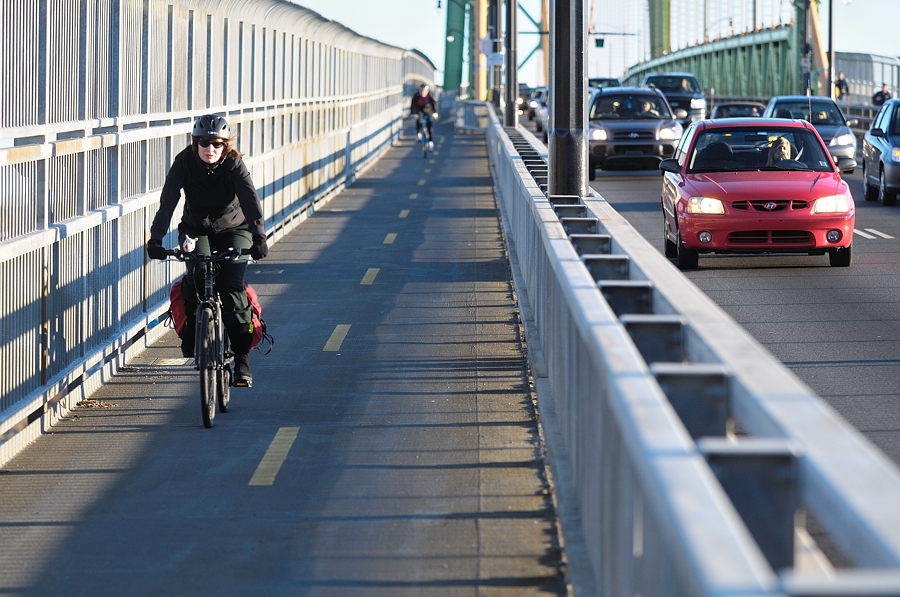
HALIFAX – The historic streets of Halifax—the narrow downtown streets, the more-than-four-street intersections, the super steep streets—predate the automobile by 150 years, and although in the last 100 years they may have belonged to the cars and trucks, in the next 100 years they may not. Sometimes, however, it seems like there is no end in sight for the automobile, with HRM’s car-centric existence fueling the way the city sounds, the way it feels, and the way it behaves. Hello Bayers Lake Shopping Center! Good day Dartmouth Crossing!
But imagine the city, our busy, crowded streets, designed for transportation alternatives, for cycling, say. What might Halifax look like?
For starters, I doubt very much that there would continue to exist a bicycle path that resembles the MacDonald Bridge bicycle on-ramp. Let me explain: What downtown Halifax lost to the Cogswell interchange, I would argue that the cycling community has lost in the MacDonald Bridge bike path. Cyclists who cross the MacDonald Bridge by bike know the problem, but for those who don’t, imagine a peaceful ride across the MacDonald bridge on your very own urban bike path. Nice hey? Now imagine that you are forced to descend four stories and then ascend those same four stories before you can access/exit the Halifax side of the bridge.
Welcome to Halifax’s MacDonald Bridge Bike Path.
For the pedestrian, it would be the equivalent of walking up and down four flights of stairs before crossing the Common (the bridge is over a kilometre long). The ramp is not so much designed for cyclists or to promote cycling in any way as it is for the benefit of drivers—the ramp diverts cyclists away from inhibiting the flow of vehicular traffic.
Why are we stuck with poorly designed active transportation infrastructure? Not because City employees are anti-cycling, its planners are dumb, or its engineers are incompetent (indeed, non of them are), but because we are a car culture. City planners no doubt contemplated more cycling-friendly designs for the MacDonald Bridge during the renovation in 1999 but ultimately ended up just reinforcing the status quo by adding an extra car lane and designing a bike lane that physically challenges even the most capable cyclist.
Like it or not, there is reason hiding behind such madness. With 32 million car crossing a year—up from 3 million a year when it was first built in the 1950s—MacDonald bridge has reached its car capacity. If car traffic continues to grow at this rate, a new bridge costing upwards of $1 billion will need to be built from the south end of the peninsula over to Highway 111 in Dartmouth.

We are a car culture. So what? Pout? Nah. Sure, cars are easy and active transportation in Halifax is not always a walk in the park. The downtown streets can sometimes feel more like a hike than a stroll, and its easy to argue that the lack of cycling infrastructure in the city makes biking dangerous. But the historic streets of Halifax have once known a car-free rather than a car-clogged existence, and they may yet again.
Improving the MacDonald bridge would be a good way to start unclogging our neighbourhoods, streets, and bridges from cars. While bikes were hardly mentioned in Steve Snider’s speech last February on the future of the MacDonald Bridge to the Halifax Chamber of Commerce, many of the ideas proposed will benefit cyclists despite not directly affecting the current state of the bike lane. Ideas like smarter bridge tolling that reflect the number of passengers in the vehicle and the time of day as well as dedicated bus lanes that increase route efficiency are all bicycle-friendly ideas that might one day end our car culture.
And what better a place to start than MacDonald Bridge, where even though the bike ramp may not be bike-friendly, the view sure is groovy.
photos by Lawrence Plug

One comment
At odds: The MacDonald Bridge gets my vote for the HEART of Halifax (for the view, as a landmark, and as a daily haunt) but is also my #1 obstacle as a cyclist.